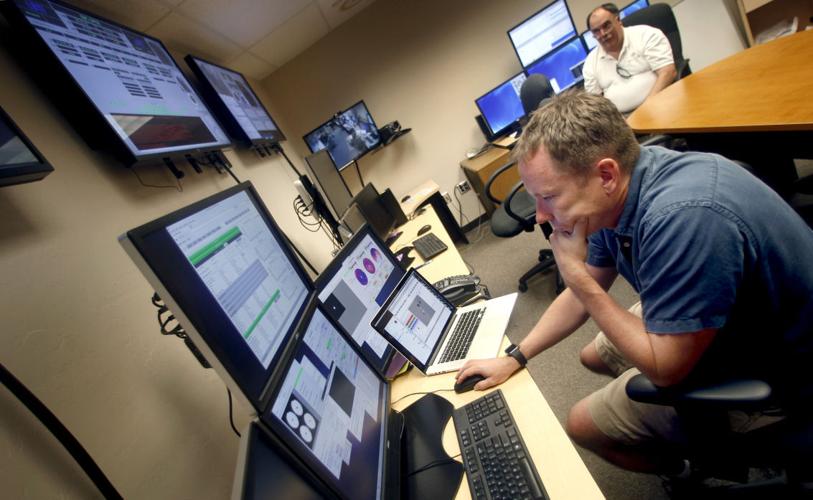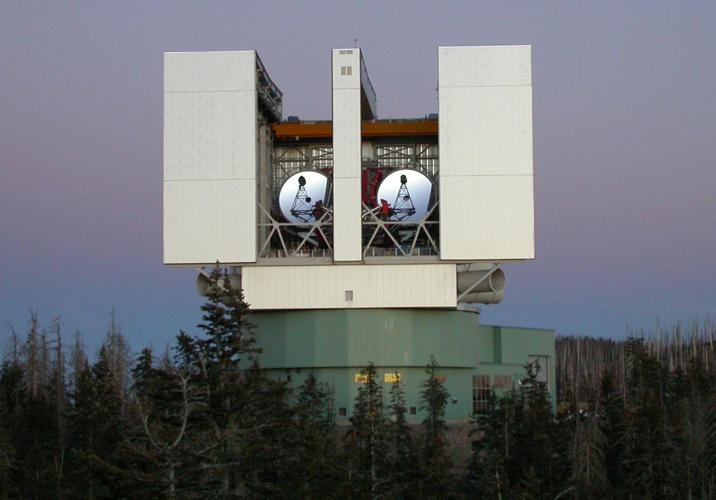We all know the impossible triangle of projects. Trying to go fast and cheap at the same time rarely ends up with a good product and, more often than not, is not as fast as planned anyway. LBT was supposed to be cheap and to move fast.
— LBT2020 draft report
The Large Binocular Telescope on Mount Graham is controversial, complex, expensive and beset by weather that kept it shuttered for half its available nights last year.
Now, 20 years after the University of Arizona received permission to build what Nobel Prize-winning astronomer Brian Schmidt calls “the most complex astronomical instrument on Earth,” it is beginning to produce the dazzling science it has always promised.
Initially, construction of the LBT was delayed by lawsuits over environmental and cultural issues. Its completion was stalled by slowly developing technology, lack of funding and instrument mismatches.
Christian Veillet, hired to direct the LBT in February 2013, says fulfilling its promise will require a change in the way the telescope is operated. It will also take additional investment from its international partners to complete the original instruments and begin building new ones.
When fully operational, a state Veillet hopes to achieve and maintain sometime soon, it will reliably deliver the performance and clarity of a telescope with a mirror nearly 23 meters (a little more than 75 feet) in diameter and be equipped with multiple instruments that can take advantage of the blur-removing magic of its breakthrough adaptive optics system.
That will give it an unrivaled edge over the biggest ground telescopes now working — until a new generation of giant telescopes, with mirror diameters of 24 to 42 meters, are built in the coming decade.
Success, finally
In late 2013, eight years after seeing “first light” on the first of its twin binocular eyes, the LBT functioned for the first time at full resolution. It combined atmosphere-corrected light from its two 8.4-meter (27 feet, 6 inches) mirrors to produce images of exoplanets around a distant star and volcanic activity on the Jovian moon, Io, that had the clarity of a telescope mirror with a 22.8-meter diameter.
Scientific papers on those observations, published earlier this year, demonstrated the LBT’s potential. Now it must fulfill it.
The LBT was built to compete with the largest telescopes in the world — its two, 8.4-meter mirrors are among the largest of the current class of a dozen large telescopes across the globe, ranging from 8.1 meters to 10.4 meters in diameter.
The earliest of the large telescopes, such as the twin 10-meter Keck telescopes in Hawaii, gathered the glory. The two Kecks achieved first light in 1993 and 1996. By 2000, astronomers using Keck produced 161 scientific papers, rising to 269 in 2011, according to a published study done by Korean astronomer Sang Chul Kim.
The LBT, meanwhile, struggled to keep its partners through a controversial battle with environmentalists over the endangered Mount Graham red squirrel and the Apache tribes who regard the peak as sacred. The chronically underfunded telescope announced “first light” on the first of its twin telescopes in 2005, and reached a high of 54 refereed papers in 2014.
“Looking back, it was so much longer than people thought in the beginning, but it is usual in astronomy. If we had told everyone 20 years ago how much it is going to cost and how long it is going to take, we would not have a telescope,” said Veillet.
Its crew hopes to pick up the pace, with a goal of 120 papers per year by the end of the decade.
“... LBTO (Large Binocular Telescope Observatory) is coming late in the game of the 8-m class telescopes. Its facility instruments, unfortunately much delayed, are not as competitive as they could have been a few years ago, though they are not yet obsolete. It is therefore very important to become operational as fully and efficiently as possible! On the bright side, the superb quality of the LBT adaptive optics will give the observatory an edge which must be exploited fully very quickly.”
— LBTO2020
One way to do that is to maximize its top science, Veillet said. That means perfecting its adaptive optics system and installing instruments compatible with it. It also means operating as a virtual 23-meter telescope whenever the weather allows.
A team led by astronomer Phil Hinz of the UA’s Steward Observatory built the machine that put all those elements together.
Hinz’s Large Binocular Telescope Interferometer, or LBTI, was built in partnership with NASA, which wants to use its capabilities to peer through the dust surrounding nearby stars — a prelude to an upcoming space telescope search for Earth-like planets.
Charles Beichman, executive director of the NASA Exoplanet Science Institute (NExScI) at Caltech, said the LBTI has done 10 times better at peering through zodiacal dust than a previous attempt by the interferometer on the Keck telescopes.
The telescope’s work “is going to be fabulous,” Beichman said. “It has tons of potential.”
NASA recently conducted a review of the LBTI and pronounced it ready for its scientific investigations.
Basically, Hinz and crew are looking at other stars to find ones that don’t have debris in their habitable zones — just as Earth orbits far from the debris in our solar system’s asteroid belt, Kuiper belt or Oort cloud.
That will let NASA target its search for exoplanets in the habitable zone.
The cost
The LBT cost $130 million to build and equip and takes about $13 million a year to operate.
Those costs are split by an international consortium of universities and national institutes: five German institutes; the Italian astronomical community, represented by the Italian National Institute of Astrophysics; Ohio State University; the Research Corporation for Science Advancement, which coordinates involvement by the universities of Notre Dame, Minnesota and Virginia.
The University of Arizona, which has a 25 percent share in the LBT, manages telescope access for all three Arizona universities.
Its annual contribution of $3.3 million consists mainly of salaries and benefits for the 60 employees of the observatory, including Veillet, who is technically a university employee but answers to the board of directors of the Large Binocular Telescope Corporation.
Joaquin Ruiz, the UA College of Science dean, said he never worried that the telescope would eventually produce great scientific results, but was concerned about the annual expenses.
“They built a Jaguar. When it’s running, there’s nothing like it,” Ruiz said.
Figuring investment, operating costs and limited nights on sky, the value of time on the telescope is estimated at nearly $90,000 a night.
“The time on sky is precious,” Veillet said. “To be ready to observe every night as soon as the sky is clear is very important.”
A proposed “queueing” program would assign the rare occurrences of “exceptional seeing” to the highest value projects.
The sophisticated systems that make that science possible are most susceptible to bad weather — and the weather on Mount Graham is often bad.
“The site of LBT is not as good as the best sites in the world. In the best observing conditions, which are relatively rare on Mt Graham, the most demanding and highly ranked programs should be executed first to optimize the scientific return.”
— LBT2020 report
“Mount Graham is not as good a site as Mauna Kea or Chile,” said Veillet. “Last year in the first semester, February to June, 35 percent was lost to weather. Second semester, mid-September to end of January, lost 50 percent to weather. Add in the (monsoon) shutdown, you lose half.”
Buell Jannuzi, director of the UA’s Steward Observatory, notes that last year was surprisingly wet. “The question is, ‘When the weather is good, is it delivering?’ And it is.”
“It is the most complex telescope on the planet,” said Schmidt, who led an external review of LBT by a “visiting committee” of prominent astrophysicists.
Their report expressed optimism that LBT is ready to “jump into the company of the world’s best observatories owing to the telescope’s unique large collecting area, binocular instrumentation possibilities and world-leading AO (adaptive optics) capabilities.”
Schmidt, who shared the 2011 Nobel Prize in Physics for co-discovering an accelerating universe driven by dark energy, said his committee urged caution in bringing new instruments online, such as a planned second interferometer, until existing systems are completed.
Technology development has been part of some partners’ goals all along, and is partly blamed for the slow speed at which the telescope developed.
Telescopes and their instruments take years to mature, said astronomer Laird Close, who has used the Italian-developed adaptive-optic systems to take breakthrough infrared images of exoplanetary systems on LBT and in visible light on the Magellan telescope in Chile.
He compares the process to building a cathedral, where architects might propose elements that are only technically possible at the time they are envisioned.
The performance of the AO system “is, in itself, a great result that makes us happy and proud,” said astronomer Adriano Fontana, who represents the Italian partners as chairman of the LBT board.
It is important, both for the LBT and because “it is a technique we can propose to apply to future telescopes.”
Fontana said the partnership now has two goals: “One is to do spectacular science — the kind of results that make other people envy they don’t have LBT.”
The other is to use the “workhorse instruments” to ramp up publication of discoveries made by the telescope.
When Roger Angel and Nick Woolf first started doodling designs for the LBT, the technology that makes it work did not exist, Angel said.
Angel, who had already embarked on a new way of casting giant primary mirrors, proposed the thin, flexible mirrors at the secondary position that could be “deformed” with electronically activated magnets to mimic the aberrations caused by an ever-changing atmosphere.
He knew the electronics for them did not exist, but was confident it would be developed by the time it was needed.
Hinz compares the de-blurring process of adaptive optics to visiting an optician, where you try a number of correcting lenses until you finally correct the deficiencies in each of your eyes — only in this case the system must measure and correct the atmospheric changes 1,000 times per second.
“Unlike your eyeball, these optics can bend and reshape themselves — give you something like a factor-of-10-better resolution. It’s a dramatic increase.”
Combining the corrected light with an interferometer was a challenge. Hinz did a “heroic job,” Angel said. “The physics of what causes light to interfere like that has been known (for a long time). Making it happen with enormous apertures takes practice and skill.”
Now the trick is to get the system to work all the time, to make it easier to run, and to have it available when the “seeing” is good.
Like all mountaintop observatories, the Mount Graham International Observatory, at 10,500 feet, gets its share of storms and is often buffeted by wind. The calculations being made for the interferometer are especially vulnerable to vibration, Hinz said. When the wind blows hard, the entire observatory vibrates.
For those times, said Veillet, he wants other instruments available that don’t need perfect conditions to do good science. An imager/spectrograph built by Ohio State, installed on both sides of the telescope, known as MODS1 and MODS2, has been a workhorse without adaptive optics, he said.
A new spectrograph called PEPSI will be able to image bright objects through thin clouds and even work around the full moon, he said.
The telescopes are ready to start producing regular scientific results, said Christopher S. Kochanek, a board member from Ohio State University.
Delays and frustrations are normal in getting a telescope up and running, Kochanek said. “In the end, it’s here and it works and you can do cutting-edge science with it.”






